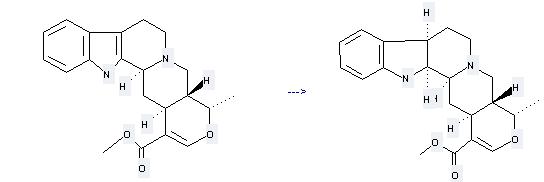-
Name
Raubasine
- EINECS 207-589-5
- CAS No. 483-04-5
- Article Data25
- CAS DataBase
- Density 1.303 g/cm3
- Solubility
- Melting Point 258°C (rough estimate)
- Formula C21H24N2O3
- Boiling Point 524.042 °C at 760 mmHg
- Molecular Weight 352.433
- Flash Point 270.731 °C
- Transport Information UN 1544
- Appearance
- Safety 22-45
- Risk Codes 25
-
Molecular Structure
- Hazard Symbols Xn
- Synonyms Ajmalicine(7CI,8CI);Raubasine (6CI);(-)-Ajmalicine;4H-Indolo[2,3-a]pyrano[3,4-g]quinolizine-1-carboxylic acid,4a,5,7,8,13,13b,14,14a-octahydro-4-methyl-, methyl ester, (4S,4aR,13bS,14aS)-;Ajmalicin;Hydrosarpan;Py-tetrahydroserpentine;Raubaserp;Tetrahydroserpentine;Vinceine;d-Yohimbine;
- PSA 54.56000
- LogP 3.11670
Raubasine Specification
The Raubasine, with the CAS registry number 483-04-5, is also known as Ajmalicine. It belongs to the product categories of Aromatics; Heterocycles; Intermediates & Fine Chemicals; Pharmaceuticals. Its EINECS registry number is 207-589-5. This chemical's molecular formula is C21H24N2O3 and molecular weight is 352.43. What's more, its systematic name is called Methyl (19α)-19-methyl-16,17-didehydro-18-oxayohimban-16-carboxylate. Raubasine is an antihypertensive drug used in the treatment of high blood pressure. It is also an alkaloid found naturally in various plants.
Physical properties about Raubasine are: (1)ACD/LogP: 2.519; (2)# of Rule of 5 Violations: 0; (3)ACD/LogD (pH 5.5): -0.08; (4)ACD/LogD (pH 7.4): 1.60; (5)ACD/BCF (pH 5.5): 1.00; (6)ACD/BCF (pH 7.4): 5.80; (7)ACD/KOC (pH 5.5): 1.39; (8)ACD/KOC (pH 7.4): 67.05; (9)#H bond acceptors: 5; (10)#H bond donors: 1; (11)#Freely Rotating Bonds: 2; (12)Polar Surface Area: 54.56 Å2; (13)Index of Refraction: 1.656; (14)Molar Refractivity: 99.371 cm3; (15)Molar Volume: 270.407 cm3; (16)Polarizability: 39.394×10-24cm3; (17)Surface Tension: 58.687 dyne/cm; (18)Density: 1.303 g/cm3; (19)Flash Point: 270.731 °C; (20)Enthalpy of Vaporization: 79.785 kJ/mol; (21)Boiling Point: 524.042 °C at 760 mmHg; (22)Vapour Pressure: 0 mmHg at 25 °C.
Preparation of Raubasine: this chemical can be prepared by (16E,19S)-17,19-epoxy-16-methoxycarbonyl-coryna-3,16-dienium; perchlorate. This reaction needs reagent (n-C4H9)3SnH and solvent methanol at ambient temperature. The reaction time is 5 min. The yield is 90 %.

Uses of Raubasine: it is used to produce other chemicals. For example, it can produce (2S,7R)-2,7-dihydroajmalicine. The reaction occurs with reagents trifluoroacetic acid, triethylsilane and the reaction temperature from 0 °C to room temperature. The yield is 85 %.

When you are dealing with this chemical, you should be very careful. This chemical is toxic if swallowed. The gas can not be breathed. In case of accident or if you feel unwell you should seek medical advice immediately.
You can still convert the following datas into molecular structure:
(1) SMILES: O=C(OC)\C4=C\O[C@H]([C@H]5CN3CCc1c(nc2ccccc12)[C@@H]3C[C@H]45)C
(2) InChI: InChI=1S/C21H24N2O3/c1-12-16-10-23-8-7-14-13-5-3-4-6-18(13)22-20(14)19(23)9-15(16)17(11-26-12)21(24)25-2/h3-6,11-12,15-16,19,22H,7-10H2,1-2H3/t12-,15-,16+,19-/m0/s1
(3) InChIKey: GRTOGORTSDXSFK-XJTZBENFSA-N
The toxicity data is as follows:
| Organism | Test Type | Route | Reported Dose (Normalized Dose) | Effect | Source |
|---|---|---|---|---|---|
| child | TDLo | oral | 12500ug/kg (12.5mg/kg) | LUNGS, THORAX, OR RESPIRATION: OTHER CHANGES BEHAVIORAL: CONVULSIONS OR EFFECT ON SEIZURE THRESHOLD BEHAVIORAL: GENERAL ANESTHETIC | Chest. Vol. 76, Pg. 97, 1979. |
| guinea pig | LDLo | intravenous | 20mg/kg (20mg/kg) | Arzneimittel-Forschung. Drug Research. Vol. 23, Pg. 600, 1973. | |
| mouse | LD50 | intraperitoneal | 165mg/kg (165mg/kg) | "Psychotropic Drugs and Related Compounds," 2nd ed., Usdin, E., and D.H. Efron, Washington, DC, 1972Vol. -, Pg. 117, 1972. | |
| mouse | LD50 | intravenous | 20mg/kg (20mg/kg) | LUNGS, THORAX, OR RESPIRATION: DYSPNEA BEHAVIORAL: CONVULSIONS OR EFFECT ON SEIZURE THRESHOLD | Naunyn-Schmiedeberg's Archiv fuer Experimentelle Pathologie und Pharmakologie. Vol. 233, Pg. 72, 1958. |
| mouse | LD50 | oral | 400mg/kg (400mg/kg) | "Psychotropic Drugs and Related Compounds," 2nd ed., Usdin, E., and D.H. Efron, Washington, DC, 1972Vol. -, Pg. 117, 1972. | |
| rabbit | LD50 | intravenous | 20mg/kg (20mg/kg) | "Psychotropic Drugs and Related Compounds," 2nd ed., Usdin, E., and D.H. Efron, Washington, DC, 1972Vol. -, Pg. 117, 1972. | |
| rabbit | LD50 | oral | 500mg/kg (500mg/kg) | "Psychotropic Drugs and Related Compounds," 2nd ed., Usdin, E., and D.H. Efron, Washington, DC, 1972Vol. -, Pg. 117, 1972. | |
| rat | LD50 | intraperitoneal | 200mg/kg (200mg/kg) | "Psychotropic Drugs and Related Compounds," 2nd ed., Usdin, E., and D.H. Efron, Washington, DC, 1972Vol. -, Pg. 117, 1972. | |
| rat | LD50 | intravenous | 24mg/kg (24mg/kg) | "Psychotropic Drugs and Related Compounds," 2nd ed., Usdin, E., and D.H. Efron, Washington, DC, 1972Vol. -, Pg. 117, 1972. | |
| rat | LDLo | oral | 750mg/kg (750mg/kg) | BEHAVIORAL: CONVULSIONS OR EFFECT ON SEIZURE THRESHOLD LUNGS, THORAX, OR RESPIRATION: DYSPNEA | Naunyn-Schmiedeberg's Archiv fuer Experimentelle Pathologie und Pharmakologie. Vol. 233, Pg. 72, 1958. |
About|Contact|Cas|Product Name|Molecular|Country|Encyclopedia
Message|New Cas|MSDS|Service|Advertisement|CAS DataBase|Article Data|Manufacturers | Chemical Catalog
©2008 LookChem.com,License: ICP
NO.:Zhejiang16009103
complaints:service@lookchem.com Desktop View